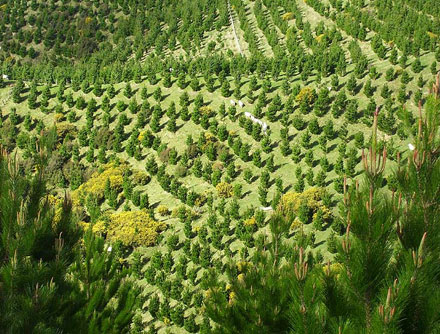
The sawmills claim the long-awaited wall of wood from forests planted in the late ’80s and ’90s was mostly leaving the country as logs, and much of the land they came from was not being replanted. Source: Radio New Zealand
Mark Hansen, the managing director of Rosvall’s sawmill in Whangarei, New Zealand said foreign investment companies were buying whole forests at point of harvest and sending the logs overseas.
He said local firms were already seeing a shortage of some grades of timber.
“If we look at the next 15 years, and the work that’s been done in protecting the grades that are going to come out of our forests, there’s some serious shortages turning up,” he said.
“We are seeing large Asian, Chinese, Japanese companies. There’s one from Dubai, and they’re all up here buying our forests, and they’re buying them on the stump. “And they’re exporting them without even offering us the grades we want.”
Mr Hansen said to make matters worse, a lot of forestry land in Northland was not being replanted.
The reasons for that go back to the 1980’s and ’90s, when many Maori landowners around the north were persuaded to amalgamate their blocks of land and lease them to forestry companies, with the promise of good returns and jobs for their children. But come harvest time that was not how it panned out.
Te Rarawa runanga chief executive Kevin Robinson said the returns had been very poor and some landowners had actually lost money. Having been burned, they were reluctant to plant more pines, even if they could afford it, and the land was reverting to weeds.
Landowners were also looking at a potentially more lucrative crop – manuka honey.
“In the Trust I’m involved with in Hokianga, we’ve considered going into beekeeping,” he said.
“We’ve purchased hives, and we’re also replanting manuka. But alongside that we’re looking at using manuka as a nursery plant and growing native trees.”
Mr Hansen said it was not for him to tell Maori landowners what to plant, but if that happened on a large scale it would jeopardise the future of the local sawmilling industry.
He said Northland pine was rated the best in the country for structural purposes.
The industry had relied on projections of a sustainable harvest of four million tonnes a year, but now feared that could drop as low as two million tonnes.
Mr Hansen said Northland sawmills had invested millions of dollars in plant, equipment and staff training in the expectation of a reliable supply from the forests planted more than two decades ago.
“We employ 50 people, 80% of them are Maori,” he said. “They’re long term staff, there’s very low staff turnover; they’re highly trained, and we’re highly mechanised.
“We’re a successful business that’s been there since 1970. We invested heavily around 2000 but in the last seven years we haven’t invested further – we haven’t got the confidence.”
Mr Hansen said the government should be encouraging Maori landowners to replant before it was too late, and possibly offer them financial support to do so.
The Northland sawmillers have asked for support from their national body, the Wood Processors and Manufacturers Association.
Mr Robinson said Northland sawmillers and landowners needed to talk and establish some certainty about what timber they would need in the future and what the returns would be.
“Maori want to know if pine forestry is going to be profitable and if it is, maybe find way to replant by working with the Crown or other investors,” he said.
Mr Hansen said the first rotation of a forest was always the most expensive because of the cost of putting in roads and other infrastructure. He believed a second harvest would be far more lucrative.
Mr Robinson said those discussions needed to happen sooner rather than later, with the imminent return to Maori of vast tracts of forest land in the north – like the Aupouri forest – through Treaty settlements.





